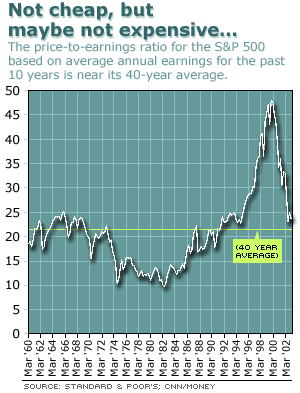NEW YORK (CNN/Money) -
If there's something that traders love more than seeing the market go up on good news, it's seeing the market go up on bad news.
So after several cheerless trading sessions, the mood brightened Tuesday when stocks managed to shrug off an out-and-out abysmal reading on the economy to nose their way higher. Signaling a deep contraction in the manufacturing economy, the Institute for Supply Management's index dropped to 46.2 in March from February's 50.5, far worse than the 48.6 economists surveyed by Reuters had expected.
"The number was built into the market," said Salomon Smith Barney director of listed trading Bob Basel. "They'd sold them already."

If such ugly economic news has already been wrung out of stock prices, what else might be? Yes, the world is a mess: The war isn't going as quickly as investors had hoped, concern over the outbreak of the atypical pneumonia SARS is spreading, and worries that the United States has again slid into recession are mounting. But at some point, stocks are low enough to account for all these things.
Perhaps the market is near that point, thinks Bollinger Capital Management head John Bollinger. He notes that volume has shriveled lately, particularly during recent bouts of selling -- rather than ditching stocks, most investors aren't doing much of anything. The suggestion is that there is a certain degree of comfort with the market at current levels -- not so much that people want to run out and buy, but enough that they don't mind holding.
That doesn't mean stocks have gone as low as they're going to get, but it could mean the market finally has a decent set of shock absorbers.
"I would have thought that with the negative tenor of the news -- economic and geopolitical -- more damage would be done," said Bollinger. "That suggests to me the market is in a constructive mode."
But just because the market may be more resistant to shock, doesn't mean that everyone wants to get their toes wet just yet. Kirlin Securities chief market strategist Tony Dwyer points out that one reason volume has dried up, besides investors sidelining themselves for the war, is that the type of action that has characterized the market has been so punishing.
Priced to buy
When stocks have rallied this year, they've tended to go up incredibly quickly -- with the kind of move that would kill anyone who's bet against the market, but would also frustrate anyone who wants to get on board.
"You can't get in when you need to because it spikes too quickly, and you can't get in early because of this continual grind lower," said Dwyer.
Such concerns aren't likely to weigh so heavily on investors who are considering buying for the long term, rather than a trade. For them, the pressing issue is whether the market is fairly priced.
Increasingly, it appears that it is. For a long time now, on more aggressive valuation models (like any that look at the market on the following 12 months estimated operating earnings) the market has looked downright cheap. But now even with more conservative valuation measures, which use past earnings under generally accepted accounting principles, stocks no longer look particularly pricey.
Take the valuation method popularized by Yale economist Robert Shiller, which compares the market to its average annual earnings, under GAAP, for the past 10 years. On that basis, the S&P 500's P/E is 23.6 -- just above its 40-year average of 21.4. That means the market is far less vulnerable to shock than it was in, say, March 2000, when the S&P's P/E under the Shiller method was 47.5.
| Related Stories
|

|
|
|
|
Shock resistant and shock proof, however, aren't quite the same thing, points out Prudential Securities strategist Ed Yardeni.
"If we have some shocks that suggest the outlook for earnings is not going to improve very quickly at all," he said, "the market will go lower."
Nor is it difficult to imagine such shocks these days, Yardeni points out. The war with Iraq may not only be longer than expected, it could set off a clash between the United States and the Arab world that could last decades. SARS, if unchecked, may develop into an epidemic which puts a huge damper on global economic growth. And on it goes.
But there is the potential for good news, as well. The war could still be blessedly short, for instance, spurring a revival in the economy and earnings that nobody quite expects anymore. Given the market's more even stance, such positive shocks could send stocks higher just as easily as negative ones could send them careening toward the gutter.

|

